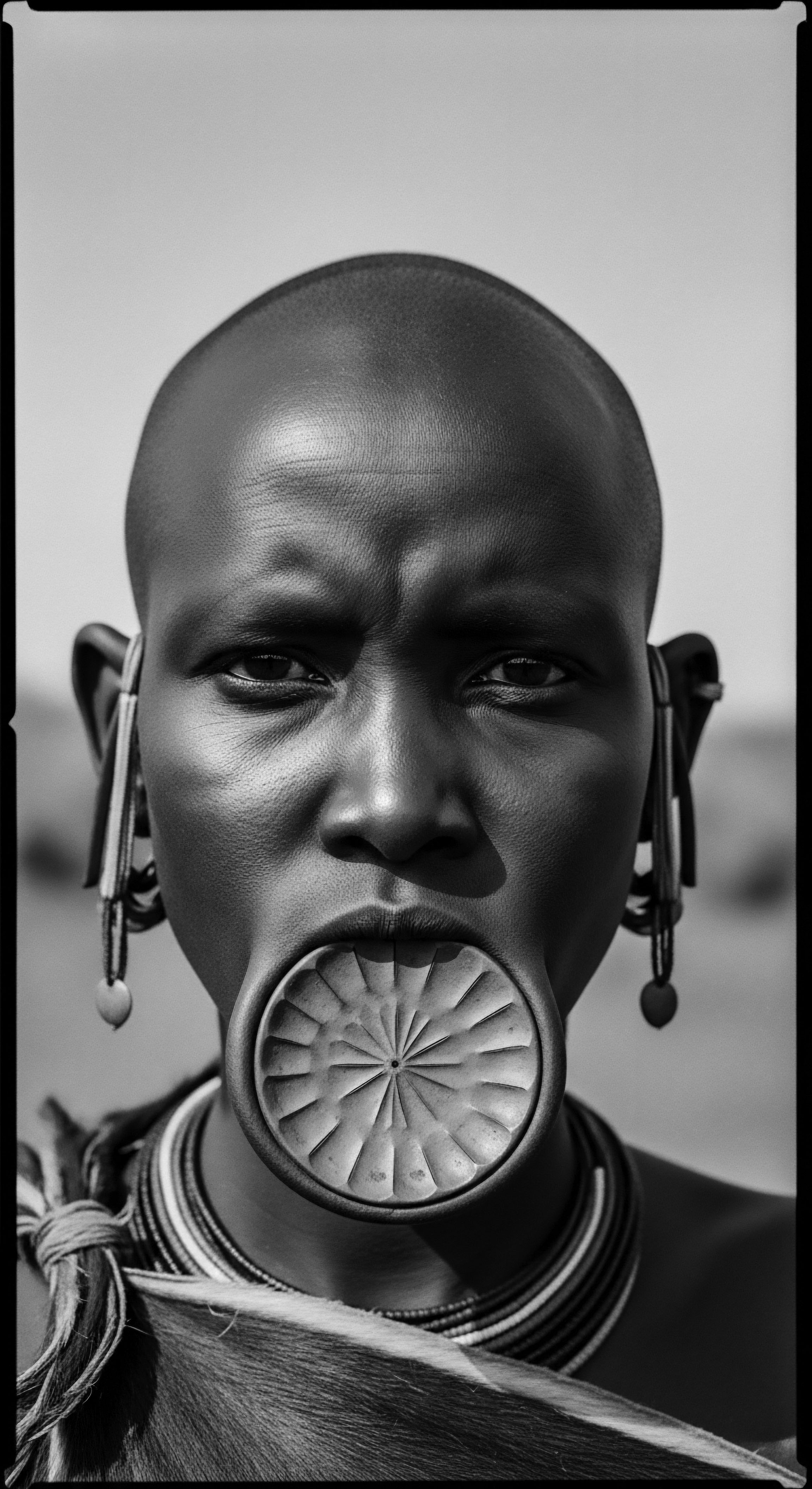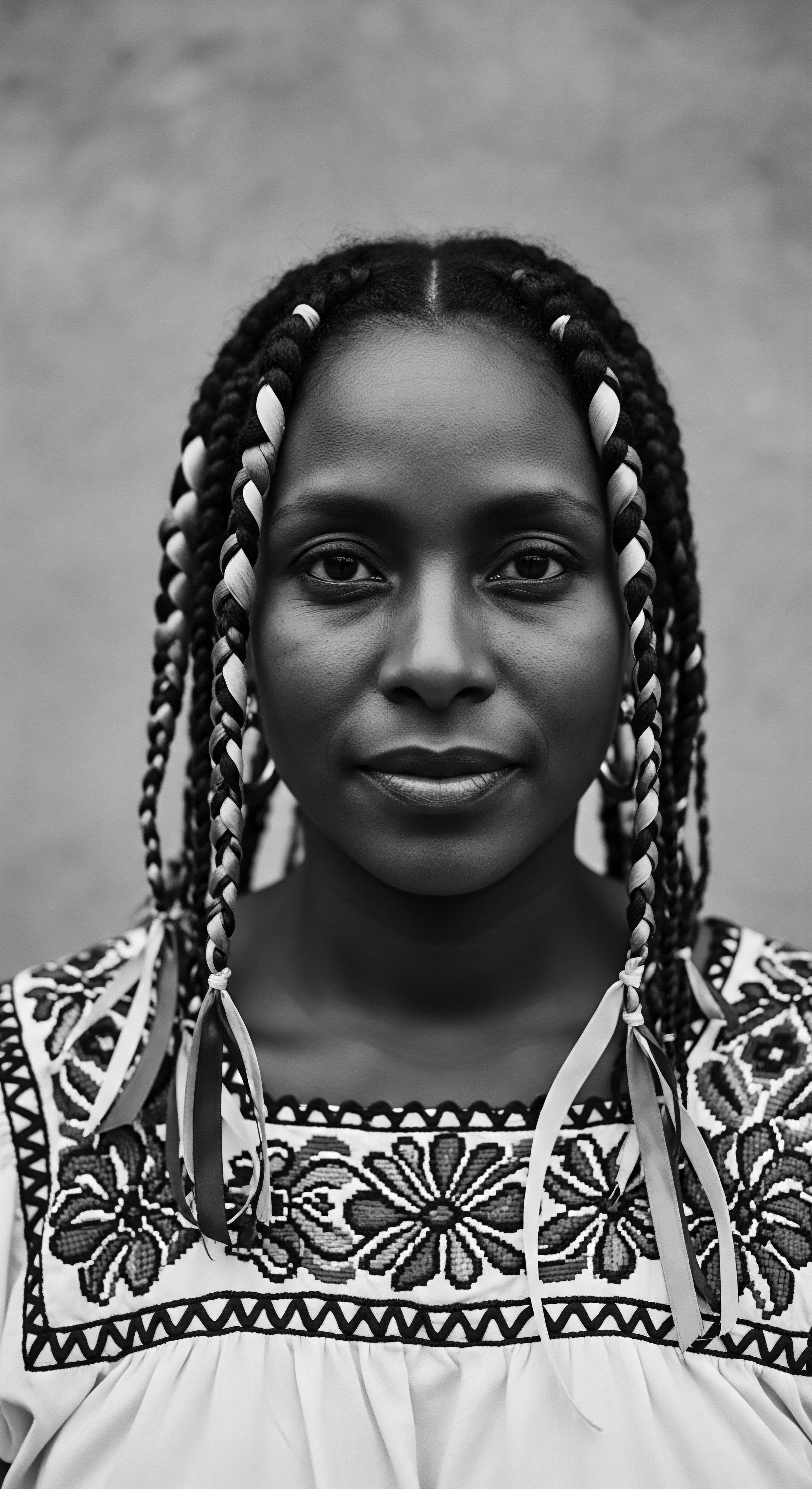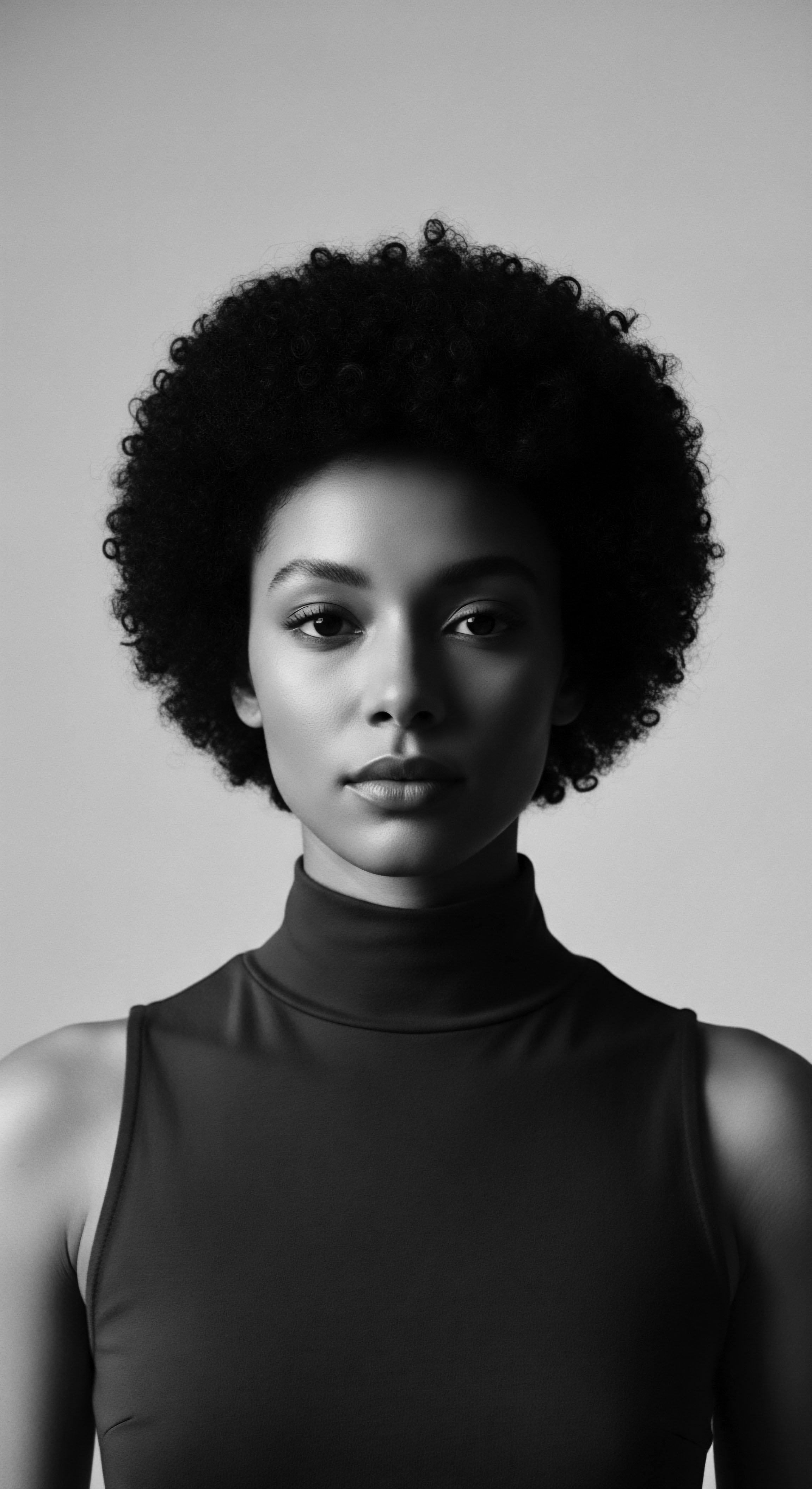
Fundamentals
The Sierra Leone Hair Culture, in its foundational understanding, represents a rich and living expression of self, community, and ancestral lineage, deeply etched into the very fibers of textured hair. It stands as a vibrant testament to an inheritance that transcends mere aesthetic preference. This collective practice, passed through generations, embodies a profound appreciation for the intrinsic qualities of Black and mixed-race hair, seeing in its coils and curls a direct connection to the land and the spirit of West Africa.
At its heart, this culture is an acknowledgment of hair as a profound marker of identity. Consider how early communities in the region, long before colonial delineations, used hair to convey messages of status, marital standing, age, and spiritual devotion. A young woman’s meticulously braided crown, for instance, might signal her readiness for marriage, while a warrior’s distinctive style could declare his victories. The designation of ‘culture’ here extends beyond fleeting trends; it points to the enduring wisdom embedded within practices that honor the hair’s natural form and its capability for meaningful expression.
Sierra Leone Hair Culture, at its core, is a vibrant, inherited appreciation for textured hair, serving as a profound canvas for identity and communal storytelling.
The interpretation of hair within Sierra Leonean communities reveals a sophisticated understanding of its significance. It is not simply about physical appearance; it also pertains to the health and vitality of the scalp, the strength of each strand, and the communal bonds fostered through shared grooming rituals. The tradition of women gathering to braid one another’s hair, for example, forms a vital social fabric, allowing for the exchange of wisdom, stories, and support. This communal aspect ensures that hair care becomes a conduit for intergenerational learning, where techniques and knowledge are transferred with deliberate care, safeguarding the unique ancestral practices.
This early understanding of Sierra Leone Hair Culture is often overlooked in contemporary discourse, which sometimes simplifies African hair practices to a singular aesthetic. However, a closer look at its delineation reveals a complex system of beauty standards and communal norms that celebrated the natural versatility of textured hair. The earliest forms of this culture, reaching back into the mists of time, were elemental in their connection to the earth’s bounty, sourcing ingredients from indigenous plants to cleanse, condition, and adorn. The knowledge of these botanicals, passed down through oral traditions, is a cornerstone of this heritage, underpinning the modern appreciation for natural and holistic hair wellness.

Intermediate
Moving beyond the foundational tenets, the intermediate understanding of Sierra Leone Hair Culture presents itself as a dynamic continuum, a journey through time where ancestral wisdom has met the currents of history, adapting and persisting. This deeper explication reveals how hair in Sierra Leone, much like the winding rivers that carve through its terrain, has always held symbolic weight, reflecting the collective experiences of its people. The connotation of hair styles, textures, and care rituals often shifts, yet the underlying current of heritage remains steadfast, anchoring communal and individual identities.

Historical Currents and Material Connections
The period marked by early European contact and the transatlantic slave trade profoundly impacted the meaning and expression of Sierra Leonean hair. Yet, even through unimaginable trauma, the culture of hair persisted, serving as a resilient channel for resistance and memory. Enslaved Africans, forcibly transported across the vast ocean, carried with them not only their physical selves but also the intricate knowledge of hair care and styling techniques.
These practices, once tied to specific ethnic markers in their homelands, transformed into a covert language of survival and a means of preserving a collective identity in new, hostile environments. The ingenuity required to maintain hair health and artistry under such dire conditions speaks volumes about the enduring spirit of this culture.
Traditional ingredients, often sourced directly from the earth, formed the backbone of hair care. These were not random choices; their effectiveness often found validation in later scientific understandings, albeit through different explanatory frameworks. Consider the widespread use of palm oil, known for its conditioning properties, or various plant-based butters and herbs whose specific benefits, from strengthening strands to soothing the scalp, were understood through generations of empirical observation. These elements formed a symbiotic relationship with the hair, recognizing its delicate biology and inherent need for nurturing care.
Hair practices in Sierra Leone demonstrate remarkable resilience, evolving from ancient botanical wisdom through colonial disruptions to assert enduring identity.
- Palm Oil ❉ Valued for its rich emollient properties, used traditionally to soften hair and add sheen, protecting strands from environmental harshness.
- Kola Nut ❉ Though primarily consumed, its derivatives and other local plant extracts were sometimes incorporated into rinses or pastes for their cleansing or stimulating qualities on the scalp.
- Shea Butter ❉ Not indigenous to Sierra Leone but traded widely, it became a cherished ingredient for its deeply moisturizing and protective attributes, particularly for denser textures.
- Native Herbs ❉ A diverse array of leaves, barks, and roots, unique to specific regions, were prepared as decoctions or poultices to address scalp conditions, promote growth, or enhance hair’s natural vibrancy.
The aesthetic preferences within Sierra Leonean hair culture also reflect a nuanced appreciation for texture and form. Braiding, an ancient art form, served beyond simple adornment. Styles could signify mourning, celebration, or even discreetly map escape routes during times of oppression.
This symbolic language was often understood only by those within the community, becoming a powerful tool for clandestine communication and a subtle assertion of agency. The intricacy of these styles spoke volumes about the skill of the practitioner and the patience of the individual being styled.

Community and Continuity
The intermediate perspective also highlights the role of communal gatherings in perpetuating hair traditions. These were not merely social events; they were vital educational spaces. Young girls observed elders, learning the precise movements of the fingers, the rhythms of the comb, and the whispered wisdom accompanying each stroke.
This process of learning through observation and participation solidified the Sierra Leone Hair Culture as a shared inheritance, a communal responsibility to preserve and transmit knowledge. The tender thread of connection woven during these sessions extended far beyond the physical act of styling hair; it fortified familial bonds and reinforced collective values.
| Traditional Practice Group Hair Braiding Sessions ❉ Communal activity, knowledge exchange. |
| Contemporary Relevance / Adaptation Salon culture and natural hair meetups ❉ Shared space, professional advice, community building. |
| Traditional Practice Use of local plant extracts and oils for moisture and scalp health. |
| Contemporary Relevance / Adaptation Emphasis on natural, organic ingredients in commercial hair products; scientific validation of botanical benefits. |
| Traditional Practice Hair as a clear social indicator of status, age, or identity. |
| Contemporary Relevance / Adaptation Hair as an intentional statement of Black identity, cultural pride, and personal expression in a globalized world. |
| Traditional Practice The enduring legacy of Sierra Leonean hair practices continues to inform and enrich contemporary approaches to textured hair care and identity. |
The collective import of these practices means that hair care in Sierra Leone is rarely an isolated act. It is a dialogue between past and present, a conversation with the hands that have tended to similar crowns for centuries. The intermediate explanation allows for a deeper appreciation of this nuanced connection, recognizing that every braid, every twist, every gentle application of a balm carries within it the echoes of countless generations, a continuous narrative of ingenuity and beauty.

Academic
The academic meaning of Sierra Leone Hair Culture delineates a complex, historically stratified, and socio-culturally dynamic phenomenon, fundamentally intertwined with the very biological architecture of textured hair, the profound spiritual legacies of West African societies, and the enduring assertions of identity forged through colonial disruption and diasporic experiences. This scholarly interpretation moves beyond surface aesthetics, aiming to comprehend its profound implications for communal cohesion, individual psychological well-being, and resistance against homogenizing cultural forces.

Echoes from the Source ❉ Biological and Ancestral Foundations
The elemental biology of textured hair, characterized by its elliptical follicle shape and varied curl patterns, intrinsically shapes the care and styling practices within Sierra Leone. Unlike simpler hair structures, these coils and kinks require particular attention to moisture retention, detangling, and protection from breakage, a reality understood implicitly by ancestral practitioners. This foundational biological truth gave rise to sophisticated care rituals that maximized the hair’s inherent resilience and unique beauty. The methods developed—from co-washing with natural clays to meticulous braiding patterns that reduced tangles and promoted growth—were direct responses to the hair’s physiological demands, long before modern trichology offered its explanations.
Ancestral practices, predating colonial incursions, viewed hair as far more than an appendage; it was a sacred conduit, a spiritual antenna, and a tangible connection to the divine. Hair styling, often conducted by elder women, possessed ritualistic significance, functioning as rites of passage or declarations of spiritual allegiance. The head, regarded as the seat of the soul, rendered its adornment a deeply spiritual endeavor.
The spiritual connection was not a superficial addition; it was the very matrix within which all hair-related activities took place. Hair, therefore, became a powerful medium for expressing cosmic order, social hierarchy, and individual spiritual journeys.

The Tender Thread ❉ Identity, Resistance, and The Sande Society
The Sierra Leone Hair Culture, as a living archive, profoundly manifests its meaning through the communal assertion of identity and resilience. One of the most compelling and deeply embedded examples of this is found within the enduring traditions of the Sande Society, particularly among the Mende People, a prominent ethnic group in Sierra Leone. This powerful women’s secret society, unique in West Africa for its overt female leadership and focus on female initiation, has historically utilized hair as a central instrument in shaping and communicating identity, particularly during crucial rites of passage.
During the intricate Bundo Initiation Ceremony, young girls transition into womanhood, a process marked by profound spiritual and social transformation. The symbolic significance of hair during this period is immense. According to ethnographer Rosalind Shaw in “Remembering Insecurity ❉ A Historical Ethnography of Death and Commemoration in Sierra Leone” (2007, p. 112), the hair of initiates is often meticulously styled, sometimes shaved, and then allowed to regrow into specific patterns that signify their new status and knowledge.
The elaborate, often geometrically precise, hairstyles of Sande Initiates and Leaders, particularly those worn by the ‘sowei’ masks (the masquerade figures embodying the Sande spirit), represent ideals of feminine beauty, wisdom, and spiritual power. These sculpted hairstyles, often lacquered with natural dyes and adornments, convey an understanding of beauty that is deeply connected to intellect, discipline, and communal responsibility.
The Sande Society’s Bundo initiation exemplifies how hair in Sierra Leone becomes a sacred canvas for profound identity transformation and the embodiment of ancestral wisdom.
The very act of shaping and adorning the hair of these initiates becomes a form of pedagogical practice, transmitting cultural norms, ethical frameworks, and the profound significance of female leadership. The hair, therefore, is not merely styled; it is imbued with the collective heritage and aspirations of the community. This practice stands as a powerful counter-narrative to external forces that sought to diminish indigenous African aesthetics or impose alien standards of beauty. The hair, in this context, becomes a visible declaration of continuity, resilience, and the assertion of an unyielding cultural identity in the face of historical pressures.
Furthermore, the maintenance of distinct traditional hairstyles within Sande contexts served as a form of resistance during colonial periods, distinguishing initiated women and reinforcing group solidarity against the homogenizing influences of missionary and colonial mandates. This specific historical example illuminates how hair culture in Sierra Leone was not a static entity but a dynamic, lived experience, continuously reaffirming ancestral practices and resisting external pressures. The meticulously crafted patterns, understood within the community, often encoded layers of spiritual knowledge and social meaning, inaccessible to outsiders.

The Unbound Helix ❉ Modern Meanings and Global Currents
In contemporary Sierra Leone, and among its diaspora, the hair culture continues its evolution. While some traditional practices might be less overtly ritualized in daily life, the inherited knowledge of hair care remains a potent force. The appreciation for natural textured hair, often termed the “natural hair movement” globally, finds deep resonance with the enduring Sierra Leonean principles of honoring the hair’s inherent characteristics. Modern practitioners and enthusiasts often unknowingly echo ancestral wisdom when prioritizing moisture, gentle handling, and protective styles, thereby demonstrating the continuous lineage of effective hair care.
The global reach of the Sierra Leonean diaspora has also contributed to the cultural interconnectedness of hair practices. From Freetown to London, New York, or Atlanta, individuals of Sierra Leonean descent carry these traditions with them, adapting them to new environments while preserving their core principles. This dynamic interaction creates new expressions of identity, blending inherited techniques with contemporary styles and products. The result is a vibrant, continuously unfolding narrative of selfhood, where hair serves as a profound connection to a rich past while simultaneously embracing an unbound future.
The academic examination also considers the psychological dimension of hair in Sierra Leonean culture. The act of hair grooming often acts as a therapeutic ritual, providing moments of self-care and communal bonding that foster mental and emotional well-being. The pride derived from a well-tended and artfully styled crown contributes significantly to self-esteem and cultural affirmation. This goes beyond superficial vanity; it taps into a deeper, inherited sense of connection to a resilient lineage that has always found ways to express beauty and identity, even in adversity.
The communal aspect of hair care, the hours spent with loved ones, creates a safe space for sharing burdens, celebrating joys, and solidifying intergenerational bonds. This collective engagement contributes to a sense of belonging, countering feelings of isolation, and reinforcing positive self-perception within a supportive environment.
- Pre-Colonial Era ❉ Hair as a spiritual conduit, social marker, and artistic expression, deeply intertwined with ethnic identity and communal rituals.
- Transatlantic Slave Trade & Colonialism ❉ Hair becomes a symbol of resistance, resilience, and coded communication, preserving identity amidst forced displacement and cultural suppression.
- Post-Colonial Period ❉ Re-emergence and adaptation of traditional styles, influencing the global natural hair movement, and serving as a continued marker of cultural pride and connection to ancestry.
- Contemporary Diaspora ❉ Blending inherited practices with modern innovations, reaffirming diverse Black and mixed-race identities on a global stage, and exploring the psychological benefits of hair care as self-affirmation.
The persistent reverence for textured hair, from its elemental biology to its most elaborate ceremonial styles, forms the undeniable meaning of Sierra Leone Hair Culture. It is a testament to the enduring power of human ingenuity, cultural resilience, and the profound beauty that arises from honoring one’s heritage, meticulously woven into each strand and style.

Reflection on the Heritage of Sierra Leone Hair Culture
Contemplating the Sierra Leone Hair Culture reveals a living, breathing testament to the enduring spirit of textured hair, its heritage a narrative spun across centuries. It is a legacy that flows from the earth’s raw bounty, through hands that have cared for generations of crowns, and into expressions of selfhood that ripple across continents. The profound significance of this culture lies not merely in its visual artistry, but in its unwavering capacity to connect us to a past rich with wisdom, struggle, and triumph.
This enduring tradition reminds us that hair is more than keratin and pigment; it is a canvas for ancestral stories, a repository of communal memory, and a vibrant declaration of identity. The meticulous care, the intricate braiding, the very act of recognizing and celebrating the unique patterns of textured hair, all serve as a continuous conversation with our forebears. Each coil, each kink, each strand carries within it the echoes of resilience, the whispers of ancient rituals, and the silent strength cultivated through immense historical challenge.
We observe that the practices of the past, often dismissed as primitive, held a scientific acuity, understanding the needs of textured hair with an intuitive grace that modern science now strives to articulate. The wisdom of botanicals, the protective power of specific styles, and the profound therapeutic value of communal grooming sessions all stand as affirmations of an inherited intelligence.
The essence of Sierra Leone Hair Culture reflects a continuous dialogue between ancestral wisdom and contemporary self-expression, affirming the profound heritage of textured hair.
As we look forward, the Sierra Leone Hair Culture offers a guiding light, reminding us that true wellness begins with honoring our inherent biology and cultural inheritance. It calls us to embrace the natural versatility of our hair, not as a trend, but as an act of profound self-acceptance and connection to a lineage of strength and beauty. The vibrant traditions of Sierra Leone, though specific in their origin, offer universal lessons in valuing what is authentic, celebrating communal bonds, and understanding the profound power of hair to voice who we are, where we come from, and where we are going.

References
- Shaw, Rosalind. Remembering Insecurity ❉ A Historical Ethnography of Death and Commemoration in Sierra Leone. Palgrave Macmillan, 2007.
- MacCormack, Carol P. Mind, Body, and Cultural Practice ❉ The Sande Society of the Mende. Indiana University Press, 1982.
- Steady, Filomina Chioma. The Poro Society as an Agency of Social Control. Journal of Asian and African Studies, 1974.
- Little, Kenneth. African Women in Towns ❉ An Aspect of Africa’s Social Revolution. Cambridge University Press, 1973.
- Opala, Joseph Amara. The Gullah ❉ Rice, Slavery, and the Sierra Leone-American Connection. USIS, 1987.
- Blier, Suzanne Preston. African Vodun ❉ Art, Psychology, and Power. University of Chicago Press, 1995.
- Perani, Judith, and Fred T. Smith. The Visual Arts of Africa ❉ Gender, Power, and Life Cycle Rituals. Pearson Prentice Hall, 1998.
